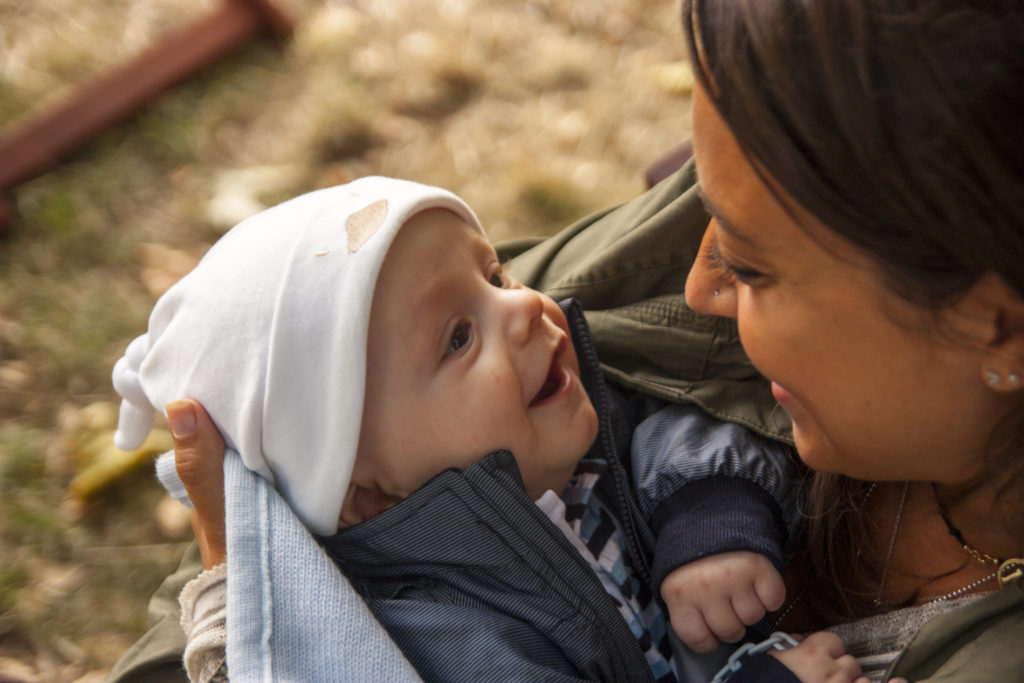Daniel Stern was my master and friend. He supported me in my endeavors with Antoinette Corboz-Warnery to describe triadic interactions by designing the Lausanne Trilogue Play (LTP) (Fivaz-Depeursinge & Corboz-Warnery, 1999) as we went about adapting the microanalytic methods he and others had developed for exploring dyadic interactions. This long journey was paved by numerous encouragements, constructive criticisms and collaborations. Thanks to his curiosity and openness to new questions, he raised issues and objections that we didn’t (want to) think of. While he had no objection to considering the triad as a system from the observer’s perspective (Stern, 2000; 2008a; Stern & Fivaz-Depeursinge, 1997), his main interrogation was whether and how the subjects, in particular the infant, experienced the triad as a whole (Stern, 2005): What were the processes by which an infant might grasp triangular interactions between herself and her two parents?; How might she communicate with both at the same time rather than sequentially, in dyads? After all, she could only look at one person at a time; and finally, how would she construct triangular representations, as a base for her participation in the family’s collective intersubjectivity?
In remembering his generous reviews of our writings, his discussions of our work at conferences and regarding our collaborative papers, I see three main moments where Daniel Stern met with us, stepped alongside us, and challenged our model.
Interfaces: In 1991, he and I convened the first interface group, in Lausanne, which included colleagues who had contrasting perspectives on infants and their families: developmental, psychodynamic, systemic. Our main goal was to draw relationships between different levels to approach the nuclear family: behavioral interactions, their subjective and unconscious meanings, and their intergenerational bases. His microanalytic interview of a parents’ couple LTP, a 30 seconds sequence of interactions, set the stage for the group’s co-construction of a common language and shared concepts. The results of this work were presented in the WAIMH Chicago conference and published in the IMHJ (Fivaz-Depeursinge, Stern, Bürgin, Byng-Hall, Corboz-Warnery, Lamour & Lebovici, 1994) along with a thoughtful and challenging discussion by Robert Emde (1994). The group’s relational history was marked by friendship, playfulness, and hot debate. This adventure was the inspiration for the plenary interfaces organized in the Paris, Yokohama and CapeTown WAIMH conferences.
Collective Intersubjectivity: In his theory on intersubjectivity as a motivational system (2004, 2005), Daniel Stern contended that intersubjectivity plays an important role in the survival of the species:
Human beings don’t survive without groups, family, team, tribe, etc. Thus is it necessary to have systems which can hold the group together. Attachment is such as a system, but intersubjectivity is also one. In a group of hunters or in a basketball team, cooperation and cohesion require to know what is in the mind of others at any time. Morality is also essential for survival. We know that there is no morality, shame, guilt, embarrassment, without intersubjectivity between persons. To experience moral emotions, one has to be able to see oneself in the eyes of another; this comes under intersubjectivity(Stern, 2005)
Basing this argument on our work, among others, Daniel Stern opened our eyes to new perspectives that we had not envisaged.
The infant’s representation of the triad as “dynamic forms”. We were privileged to witness Daniel Stern’s struggle with the question of the infant’s capacity to represent a triad as a Gestalt. After imagining many different mechanisms, for instance combining a dyad in the foreground with a third party in the background, he squarely asked how the infant could hold three characters in mind simultaneously:
Given a triad is not made up of three separate dyads seen sequentially (additively), but rather of one threesome, all three characters must be held in mind simultaneously. How could an infant do that and then represent it? (Stern, 2008, oral presentation)
Later, in a discussion of our work in Rome he proposed to deal with this question in terms of “dynamic forms”. Recalling that:
The baby is aware of his own movements through proprioception as he is aware of his parents movements visually and auditively, it is relatively easy to see how the baby would be aware of the dynamic patterns of motion (speed, duration, force, direction relative to another or self, etc). The harder question is how could all the simultaneous dynamic forms of three separate people be integrated by the baby into a whole, into an overarching dynamic form? (Stern, 2008b)
In answer to this question, Daniel Stern told of a personal experience which he considered to be directly relevant to the dynamic interactions that babies engage in with their parents. First, he spoke of dancers: .
There is an exercise for improvisional modern dancers that asks a room full of a dozen or so dancers to walk around aimlessly. While they are doing that, each is to hold one specific – “target” other person in the left visual field and a second specific-target person in the right visual field. To best do this while you and everyone else is moving, one should not in fact look at either of the two target people but anywhere else to hold them both in separate peripheral vision spaces. It is remarkably easy; the only hard part is not bumping into all the other moving people. (Stern, 2010a, p. 123)
Next, he referred this dance exercise, back to the baby in the LTP:
The parents play together with their 9 month-old. Having tried several games, they finally settle to play “sneezing”. The two parents call for the baby’s attention: “Attention! attention!!, attention !!!”…The baby looks at them with awe, they pause a bit more and then they both sneeze together. The baby laughs; then he looks up at father, at mother, anticipating the next round. The parents go on… the excitation rises with each turn, until they all break into a joint laughter (Stern, 2008b).
Of this dynamic dance of interaction, he commented:
The dynamic forms are numerous. The parents’ signals are different, to some extent – the father’s firmer movements and low voice contrasting with the mother’s smoother movements and higher voice, but both on the same rhythm and tune…etc. The diversity makes for the richness of the stimulation; but they are sufficiently synchronized and coordinated to form together with the baby’s responses an overarching Gestalt… At the level of the threesome, it begins with a well marked staccato, in three steps, then a pause, then the sneezing explosion…etc.” (Stern, 2008b)
Finally, the parallels between choreography and human interaction were great inspiration for Daniel Stern; and for me, his last book on “Forms of Vitality” (2010b) is the most fundamental of his works. At heart it examines how we know that we are alive; and it captures his style which was the very embodiment of human vitality and will remain alive in our minds.
References
Emde, R. (1994). Commentary: Triadification experiences and a bold new direction for infant mental health. Infant Mental Health Journal, 15(1), 90-95.
Fivaz-Depeursinge, E., Stern, D. N., Bürgin, D., Byng-Hall, J., Corboz-Warnery, A., Lamour, M., & Lebovici, S. (1994). The dynamics of interfaces: Seven authors in search of encounters across levels of description of an event involving a mother, father, and baby. Infant Mental Health Journal, 15(1), 69-89.
Fivaz-Depeursinge, E., & Corboz-Warnery, A. (1999). The Primary Triangle. A Developmental Systems view of Fathers, Mothers and Infants. New York: Basic Books.
Stern D. N. (2000). Introduction to the Paperback Edition. The Interpersonal world of the Infant. A view from Psychoanalysis & Developmental Psychology. New York: Basic Books.
Stern, D. N., Fivaz-Depeursinge, E. (1997). Construction du réel et affect. Cahiers Critiques de Thérapie familiale et de réseaux, 18 (1), 77-85.
Stern D. N. (2004). The Present Moment in Psychotherapy and Everyday Life. New York:: W.W. Norton.
Stern, D. N. (2005). Le désir d’intersubjectivité. Pourquoi ? Comment ? Cahiers critiques de thérapie familiale et de pratiques de réseaux, 35 (29-42).
Stern, D. N. (2008). The clinical relevance of Infancy. A progress report. Infant Mental Health Journal, 29 (3), 177-188.
Stern, D. N. (2008b). The issue of internal representations in dyads and triads. Discussion of Fivaz-Depeursinge: “The infancy of triangular communication in the family.” Rome, Conference on Gestalt Therapy, Jan. 25-27, 2008.
Stern, D. N. (2010a). Foreword to Fivaz-Depeursinge, Lavanchy-Scaiola, and Favez . Psychoanalytic Dialogues, 20 (121-124).
Stern, D. N. (2010b). Forms of Vitality: Exploring Dynamic Experience in Psychology, the Arts, Psychotherapy, and Development (2010). Oxford University Press.
Daniel Stern, the Baby and the Triad
Authors
Fivaz-Depeursinge, Elisabeth,
Switzerland








